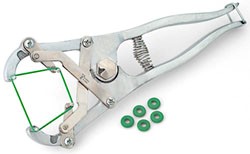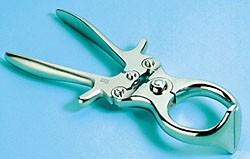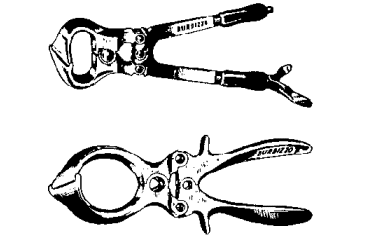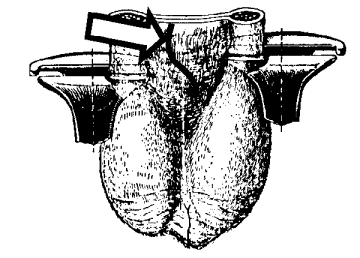
Knife Castration
Knife castration is the only completely safe method to sterilise male animals and can be done at any age, although with older animals the task is best left to a qualified veterinarian. With this method of castration, there is always a danger that the wound can become infected and the necessary precautions must be taken.
With young animals, the lower part of the scrotal sack is cut off and each testicle is removed by cutting the membrane enclosing the testicle and the relevant testicle is extruded. The spermatic cord and arteries are cut off using a scraping action to inhibit bleeding. Tying off the spermatic arteries can also be used to prevent excessive bleeding.
Elastrator Rings

Elastrator rings were developed to castrate sheep and have subsequently come into use to castrate bull calves. A rubber ring, the elastrator ring, is applied around the neck of the scrotal sack using the special instrument designed for this purpose. The testicles must be in the scrotal sack distal (away from the body of the calf) to the elastrator ring. After a while, the testicles and that part of the scrotal sack distal to the elastrator ring degenerates and falls off.
Where fat deposition is not desired, but the farmer wants the higher growth rates associated with intact males, short scrotum castration can be done. The testicles are pushed up against the body of the bull and the elastrator ring is applied to the scrotum distal (away from the body) to the testicles but in a manner that will keep the testicles firmly in contact with the body. Such a bull is sterile, grows well and fat deposition is the same as with intact males.
Many veterinarians believe that the use of elastrator rings in cattle is inhumane. To minimize pain when using the rubber ring method of castration, they must be applied within three days of birth, which can be a problem because in some calves the testicles remain in the body cavity for a time post-partum.
Burdizzo

The burdizzo is an instrument used to cut off the blood supply to the testicles, causing cell death of the testicular tissues resulting in degeneration of the testicles. The best time to apply the burdizzo is as soon as the spermatic cords can be felt, which three to four weeks after birth is. In older animals the burdizzo does not work well because the connective tissue in the spermatic cord thickens with age, preventing the instrument from performing its task. Bulls older than 4 months become increasingly difficult to burdizzo as they get older.

Cattle burdizzo (top) and sheep burdizzo (bottom; not drawn to scale). When storing burdizzo's it is best to leave the jaws open in order to prevent wear on the edges of the jaws.
The burdizzo is applied to each spermatic cord separately in such a way that the blood supply to the testicles is damaged, while circulation to the scrotal sack remains intact. Gangrene can set in where blood circulation to the scrotum is lost. To achieve these objectives, the burdizzo is applied to the individual spermatic cords at opposite sides of the scrotum, leaving a central area free for blood to circulate or applying the burdizzo at different levels on opposite sides of the scrotum.

Applying the burdizzo to one spermatic cord at a time.

Illustration to show how the burdizzo is applied to opposite sides of the scrotal sack at different levels, leaving a space between the pinched areas, in order to preserve the circulation (arrowed line) to the lower part of the scrotum.
Castration with a burdizzo is best performed by two persons. The calf is first immobilized (e.g. tying it with ropes) or placed in a crush with a thick pole behind its hocks to prevent it from kicking. Holding an animal’s tail firmly in a vertical position is very effective in preventing it from kicking, which requires a third handler. One handler holds the burdizzo and opens its jaws. The second handler guides the burdizzo, first moving a spermatic cord to the side of the scrotal sack, after which the relevant cord is hooked over the tooth at the side of the one jaw of the burdizzo. The first handler is then instructed to close the jaws slowly, while the second handler ensures that the spermatic cord does not slip out from between the jaws. Once the burdizzo is closed to the point where the spermatic cord can no longer slip out, the first handler closes it with an even, firm motion. Slamming the jaws shut must be avoided to prevent tearing the skin. The burdizzo is left closed for five to six seconds. The second cord is then nipped on the opposite side of the scrotal sack using the same technique. Cutting off the blood supply to the testicles causes ischemia (loss of oxygen to a body part), causing the death of the testicular tissues. With successful castration, on the day after castration, the testicles are swollen. Over a period of weeks, the testicles shrivel up and are replaced with connective - and fat tissue.